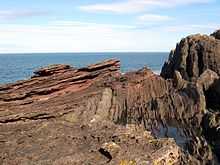Hutton's Unconformity
Hutton's Unconformity is a name given to various famous geological sites in Scotland identified by the 18th-century Scottish geologist James Hutton as places where the junction between two types of rock formations can be seen. This geological phenomenon marks the location where rock formations created at different times and by different forces adjoin. For Hutton, such an unconformity provided evidence for his Plutonist theories of uniformitarianism and the age of the Earth.
In a search for such a juxtaposition, Hutton, accompanied by some of his friends, examined sea cliffs and found examples at several locations where the two rock types had been laid bare, the most famous being at Siccar Point.
Theory of rock formations
Hutton hit on a variety of ideas to explain the rock formations he saw around him, and after some 25 years of work,[1] his Theory of the Earth; or an Investigation of the Laws observable in the Composition, Dissolution, and Restoration of Land upon the Globe was read to meetings of the Royal Society of Edinburgh in 1785.

Later that year Hutton read an abstract of Concerning the System of the Earth, its Duration and Stability to a Society meeting, and had it printed and circulated privately. In it, he outlined his theory that the "solid parts of the present land appear in general, to have been composed of the productions of the sea, and of other materials similar to those now found upon the shores."
From this he deduced that the land was a composition which had been formed by the operation of second causes in an earlier world composed of sea and land, with tides, currents, and "such operations at the bottom of the sea as now take place" so that "while the present land was forming at the bottom of the ocean, the former land maintained plants and animals; at least the sea was then inhabited by animals, in a similar manner as it is at present", and that most, if not all, of the land had been produced by natural operations involving the consolidation of masses of loose materials collected at the bottom of the sea, followed by the elevation of the consolidated masses to their present position.[2]
Hutton's search for unconformities
Angular unconformities had been noted by earlier geologists who interpreted them in terms of Neptunism as "primary formations", so Hutton wanted to examine such formations himself to look for support for his theory of Plutonism.

On a trip to the Isle of Arran in 1787 he found his first example of an unconformity to the north of Newton Point near Lochranza, but the limited view did not give the information he needed.[3][4] It occurs where vertically oriented Precambrian Dalradian schists are overlain by more recent cornstones in the Kinnesswood Formation of the Inverclyde Group (Lower Carboniferous), with an obvious difference in dip between the two rock layers,[5][6] but he incorrectly thought that the strata were conformable at a depth below the exposed outcrop.[7]
Later in 1787 Hutton noted what is now known as the Hutton Unconformity at Inchbonny, Jedburgh, in layers of sedimentary rock.[8] He later wrote of how he "rejoiced at my good fortune in stumbling upon an object so interesting in the natural history of the earth, and which I had been long looking for in vain." That year he found the same sequence in Teviotdale.[3]
In the spring of 1788 he set off with John Playfair to the Berwickshire coast and found more examples of this sequence in the valleys of the Tour and Pease Burns near Cockburnspath.[3] They then took a boat trip from Dunglass Burn east along the coast with the geologist Sir James Hall of Dunglass. They found the sequence in the cliff below St. Helens, then just to the east at Siccar Point found what Hutton called "a beautiful picture of this junction washed bare by the sea".[9] Continuing along the coast, they made more discoveries including sections of the vertical beds showing strong ripple marks which gave Hutton "great satisfaction" as a confirmation of his supposition that these bed had been laid horizontally in water.[3]
On us who saw these phenomenon for the first time the impression will not easily be forgotten...We felt necessarily carried back to a time when the schistus on which we stood was yet at the bottom of the sea, and when the sandstone before us was only beginning to be deposited, in the shape of sand or mud, from the waters of the supercontinent ocean... The mind seemed to grow giddy by looking so far back into the abyss of time; and whilst we listened with earnestness and admiration to the philosopher who was now unfolding to us the order and series of these wonderful events, we became sensible how much further reason may sometimes go than imagination may venture to follow.|source=John Playfair (1805) Transactions of the Royal Society of Edinburgh, vol. V, pt. III.[12]
At Siccar Point, layers of lower Silurian greywacke laid down in a deep-sea environment around 425 million years ago have been tilted vertically, then overlaid by strata of Upper Devonian sandstones which were deposited on a broad coastal plain subject to periodical flooding by the sea, around 345 million years ago.[13]
-

Hutton's Unconformity on Arran
-

Hutton's Unconformity at Siccar Point, eroded outcrop, as sketched in 1788 by Sir James Hall.
-

Cliff at the east of Siccar Point showing the unconformity between red sandstone and greywacke.
See also
| Wikimedia Commons has media related to Hutton's Unconformities. |
References
- ↑ "The Theory of the Earth". James Hutton.org. Retrieved 2008-04-11.
- ↑ Concerning the System of the Earth abstract
- ↑ 3.0 3.1 3.2 3.3 Keith Montgomery (2003). "Siccar Point and Teaching the History of Geology" (pdf). University of Wisconsin. Retrieved 2008-03-26.
- ↑ "Hutton's Unconformity - Lochranza, Isle of Arran, UK - Places of Geologic Significance on Waymarking.com". Retrieved 2008-10-20.
- ↑ "Arran – Hutton’s Unconformity". scottishgeology.com. Retrieved 22 November 2012.
- ↑ "Hutton's Unconformity". Isle of Arran Heritage Museum. 18 July 2008. Retrieved 2008-10-20.
- ↑ Hugh Rance (1999). "Hutton's unconformities" (pdf). Historical Geology: The Present is the Key to the Past. QCC Press. Retrieved 2008-10-20.
- ↑ "Jedburgh Official Website". Hutton's Unconformity. Retrieved 8 July 2011.
Whilst visiting Allar's Mill on the Jed Water, Hutton was delighted to see horizontal bands of red sandstone lying 'unconformably' on top of near vertical and folded bands of rock.
- ↑ Hutton’s Journeys to Prove his Theory
- ↑ McKirdy, Alan Gordon, John & Crofts, Roger (2007) Land of Mountain and Flood: The Geology and Landforms of Scotland. Edinburgh. Birlinn. Page 253.
- ↑ Gillen, Con (2003) Geology and landscapes of Scotland. Harpenden. Terra Publishing. Page 95.
- ↑ John Playfair (1999). "Hutton's Unconformity". Transactions of the Royal Society of Edinburgh, vol. V, pt. III, 1805, quoted in Natural History, June 1999.
- ↑ Cliff Ford (2 September 2003). "Siccar Point". Field Excursion Preview. University of Edinburgh School of GeoSciences. Retrieved 2008-10-20.